What did the Picts really wear?
Did the Picts did not look like this

A late-16th century, fanciful Giclee print of a Pictish warrior with spear and shield. (clearly based on Herodian’s description of the “barbarians” of Caledonia) by John White.
We see these depictions all the time, of naked blue people adorned with tattoos and maybe a severed head or two. But evidence shows us they looked was quite the opposite. It’s an incomplete jigsaw puzzle as not much is known, but what we do know is they didn’t look like this, well not all the time.
So Why Blue?
The overall blue tinting of the body is inspired by a remark made by Julius Caesar, who had spent a few weeks in the south-eastern corner of Britain in 55BC and 54BC: “All the Britons, without exception, stain themselves with woad, which produces a blueish tint; and this gives them a wild look in battle.”. Julius Caesar never spent any time here and certainly never travelled up to the North (Pictland).
Who were the Picts?
The origins of the name Pict has been much debated. . What they called themselves is not known – the Picts left no literature – but the Latin word Picti would appear to mean ‘painted people’ (pictus = ‘painted’, hence the English word ‘picture’). It was the Romans that termed the various tribes people of Britain ‘Picts’. In 208, Septimius Severus arrived in Britain to campaign against the tribes of Caledonia (the Maeatae and the Caledonians). Herodian, a contemporary of Severus, writes:
“Most of the regions of [northern] Britain are marshy, since they are flooded continually by the tides of the ocean; the barbarians are accustomed to swimming or wading through these waist-deep marsh pools; since they go about naked, they are unconcerned about muddying their bodies. Strangers to clothing, they wear ornaments of iron at their waists and throats; considering iron a symbol of wealth, they value this metal as other barbarians value gold. They tattoo their bodies with coloured designs and drawings of all kinds of animals; for this reason they do not wear clothes, which would conceal the decorations on their bodies. Extremely savage and warlike, they are armed only with a spear and a narrow shield, plus a sword that hangs suspended by a belt from their otherwise naked bodies. They do not use breastplates or helmets, considering them encumbrances in crossing the marshes.”
Herodian ‘History of the Empire after Marcus’ Book III Chapter 14
Almost a century after Severus, the name Pict appeared (297). Another century later, in 400, the poet Claudian talked of Britain (in female personification) being:
“… clothed in the skin of some Caledonian beast, her cheeks tattooed, and an azure cloak, rivalling the swell of Ocean, sweeping to her feet …”
Claudian ‘De Consulatu Stilichonis’ (On the Consulship of Stilicho) Book II
And, in 402, of:
“… the strange devices tattooed on dying Picts.”
Claudian ‘De Bello Gothico’ (On the Gothic War)
And he had, in 396, referred to:
“… the well-named Picts …”
Claudian ‘Panegyricus de Tertio Consulatu Honorii’ (Panegyric on the Third Consulship of Honorius)
Possibly, then, it was their tendency to decorate themselves with extravagant body-art that caused the Romans to nickname them Picti: ‘painted people’. On the other hand, maybe the association of tattooing with British “barbarians” was based not on reality, but on a stereotyped notion of those distant savages. In other words, perhaps it was a myth that the Picts tattooed their bodies. The British cleric Gildas, writing in about 545(?), who refers to the Picts and the Scots as “dark swarms of worms”, and says of them:
“Differing partly in their habits, yet alike in one and the same thirst for bloodshed – in a preference also for covering their villainous faces with hair rather than their nakedness of body with decent clothing …”
Gildas ‘De Excidio Britanniae’ Chapter 19
Gildas most definitely been disparaging when describing these ‘barbarians’. Nevertheless, in the early-600s, the Spanish bishop and encyclopaedist, Isidore of Seville wrote:
“It is not simply in clothing but in physical appearance also that some groups of people lay claim to features peculiar to themselves as marks to distinguish them, so that we see the curls [perhaps topknot] of the Germans, the mustaches and goatees of the Goths, the tattoos of the Britons. The Jews circumcise the foreskin, the Arabs pierce their ears, the Getae with their uncovered heads are blond, the Albanians shine with their white hair. The Moors have bodies black as night, while the skin of the Gauls is white. Without their horses, the Alans are idle. Nor should we omit the Picts, whose name is taken from their bodies, because an artisan, with the tiny point of a pin and the juice squeezed from a native plant, tricks them out with scars to serve as identifying marks, and their nobility are distinguished by their tattooed limbs.”
sidore of Seville ‘Etymologiae’ (or ‘Origines’) Book XIX Part 23 No. 7
The image of the highly decorate Pict seems to have stuck in the public’s imagination. Their defining feature to the point they are depicted naked and covered in tattoos.
So what ‘evidence’ do we really have about Pictish Dress
While it is nearly impossible to say anything absolutely conclusive about Pictish dress, this need to carefully piece together the information that does exist makes for very interesting research.
Pictish Dress shown on Stone Carvings

Picture Rhynie Man Pictish Standing Stone

St Viegans stone
From stone carvings we can tell they would have worn tunics and been very covered up, especially the women who are all depicted as wearing ankle length tunics. Men were a bit more daring and wore varied lengths.

Pictish Hilton of Cadboll stone
The Orkney Hood

The Orkney Hood – real evidence
This is the most complete clothing found from Pictish times. Is incredible it’s survived.
It’s from St Andrew’s Parish, Orkney. The Orkney Hood is dates to about 200-615AD and so may be earlier than the Pictish period, but evidence is so sparse. The entire hood is made of wool and the body of the hood is a 2/2 herringbone twill while the bands are tablet woven with two or four hole tablets. The fringe is woven as part of one of the two tablet woven bands and is as long as 11-12 inches. The primary construction stitches are running stitches, hem stitches, and overcast or whip stitches. Based on the wear on the fibers and that the fringed tablet weaving does not seem to be quite long enough, it seems that the fibers may be recycled from other garments.
Other Archaeological Evidence
- The Falkirk fragment, a third century find from Stirlingshire
- Meant that they wore some kind of cloak/wrap
- High status Pictish silver chain, one of ten known to exist, dating from between 400 and 800 AD.
- The 8th or 9th Century piece of jewellery, found in north-east Fife, has caused excitement in archaeological circles.
- The Rogart brooch, National Museums of Scotland, FC2. Pictish penannular brooch, 8th century, silver with gilding and glass.
Here’s a great pdf showing the evidence in archaeology and in stone carvings about what the Picts would have worn:
http://eithni.com/referencedesk/TheWell-DressedPict.pdf
So Picts maybe weren’t straight out of Avatar.
Tagged






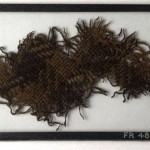
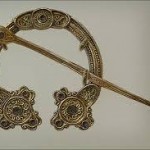
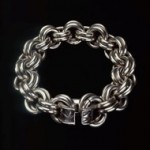
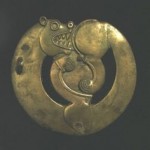
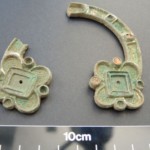
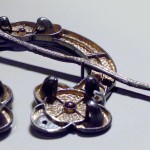





About the origins of the name “Pict”: “The first historical appearance of the term ‘Pict’ occurred in 297 CE in a Roman speech. The term is not Celtic, but of Latin derivation, and refers to the Roman soldiers’ nickname for Celtic warriors who painted or tattooed themselves, from the Latin pictii, the past participle of pingere, ‘to paint.’” From my book, The Origins of the Mure Family.
From what I’ve been able to learn, woad is not a stable pigment for tattooing. They may have painted decorations on their skin with woad, but if they did have tattoos, they were created with other pigments. Also, the Picts may have used woad as a method of treating and preventing fungal skin infections. Since they lived in a marshy area, I would think they were probably prone to fungal infections. Woad is very effective at curing fungal infections, although it does turn you blue for a while.
Hi – yes! I run a very large Facebook group and we are forever getting the blue naked pict pictures posted. Every time I just point them to the pdf, has been so helpful! Have searched for information in other places and just not found it. Thank you so much for creating it. If you ever want to publish a blog here – please just contact me: amanda@scotclans.com.
Wonderful article and photography of Pict artifacts. I believe Brian Sykes, renown geneticist anthropologist from Oxford
University and Research specialist of worldwide DNA, has narrowed down what YDNA is of the Pick lineage. Have
you ever heard such?
Thanks again for the sharing the awesome article.